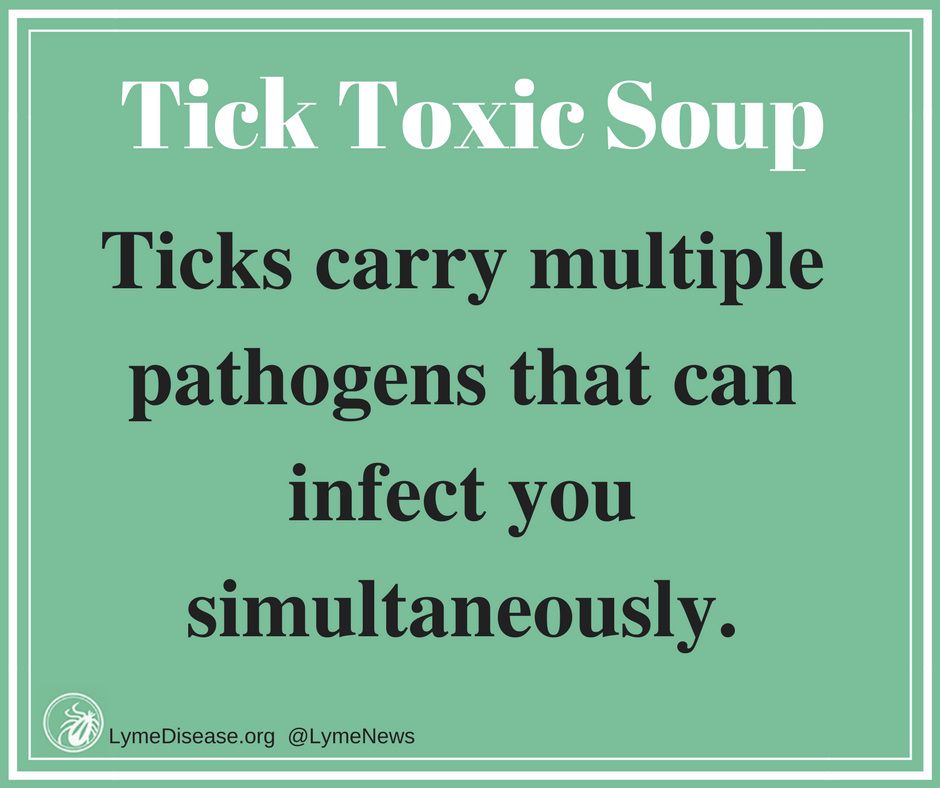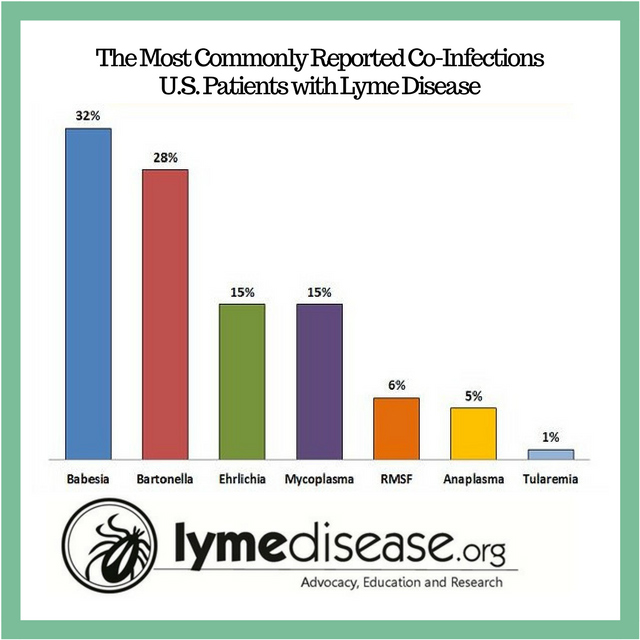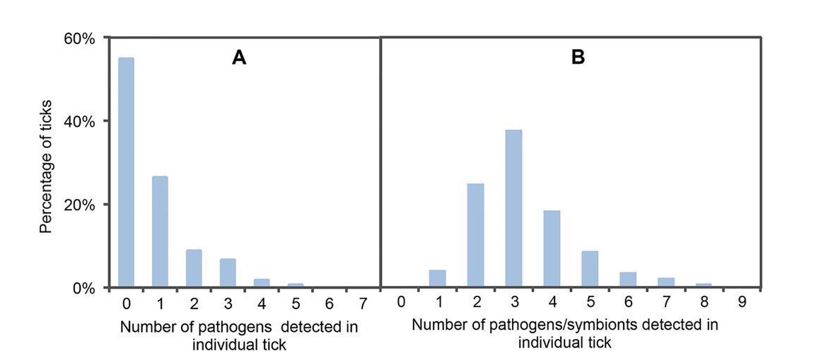LYME SCI: Tick-borne co-infections are the rule, not the exception

While Lyme disease is the fastest growing vector-borne disease in the United States, many other bacteria, parasites and viruses can also be transmitted by ticks.
These are generally referred to as “co-infections” of Lyme, since people often have them at the same time as Lyme disease. While US cases of Lyme disease are estimated to be over 300,000 per year, no one really knows the incidence of co-infections.
In a LymeDisease.org survey of over 3,000 patients with chronic Lyme disease, more than half reported laboratory-confirmed co-infections, with 30% having two or more. According to Dr. Richard Horowitz, “The existence of these co-infections explains why some people with Lyme remain chronically ill even after treatment.”
The most common co-infections reported with Lyme disease are Babesia (32%), Bartonella (28%) and rickettsial illnesses (26%). Rickettsial illnesses include ehrlichiosis (15%), Rocky Mountain spotted fever (6%), and anaplasmosis (5%).
Ticks transmit 94% of vector-borne diseases
Most vector-borne diseases (VBDs) in the United States are transmitted by ticks. Of the nearly 50,000 cases of VBDs reported to the Centers for Disease Control (CDC) in 2014, 94% were tick-borne, with most of those being Lyme disease. Only 6% of VBDs were from mosquitoes. Yet, Lyme receives only a fraction of the research funding given to Zika and West Nile virus.
The recognition of tick-borne pathogens that are responsible for human illness is accelerating. Eleven new ones have been discovered since 1960, with over half of those found since 2000.
Several factors contributing to the increase of TBDs
- Improved diagnostics
- Climactic changes (warm wet weather)
- Reforestation and population increases of mice/deer
- Range expansion and population increases of ticks
- Lack of single, effective, widely accepted preventative strategy
Ixodes (hard-bodied) ticks
Of the 84 species of ticks found in the U.S., at least a dozen can infect humans. Ixodes (hard-bodied) ticks are the biggest culprits, known to transmit a large number of bacteria, parasites and viruses.
According to the CDC, seven out of the 18 reportable tick-borne diseases in the US are attributable to Ixodes ticks. The main vectors are Ixodes scapularis (blacklegged tick or deer tick) found east of the Rockies, and Ixodes pacificus (western blacklegged tick) found west of the Rockies.
Known pathogens transmitted by Ixodes ticks:
- Anaplasma phagocytophilum
- Borrelia burgdorferi
- Borrelia miyamotoi
- Borrelia mayonii
- Babesia microti
- Ehrlichia muris
- Powassan virus
Co-infections are the rule
To better understand how many microbes can be carried by ticks, scientists are going straight to the source—the tick. One such study took a deep dive into the pathogens carried by Ixodes ticks. While this research was conducted in France, I believe the conclusions are applicable to Ixodes ticks found throughout the world. Basically, ticks carry lots of bad stuff!
This study was the first to simultaneously test for 38 pathogens (bacteria, parasites and viruses) and four symbionts (other microorganisms that may affect the transmission of disease). Some symbionts may make it harder for the tick to transmit pathogens, while others may make it easier.
The results were astonishing! Every tick carried at least one symbiont, and 45% were co-infected with up to five different pathogens. When you include symbionts in the count, some ticks carried as many as eight microorganisms. The study’s findings are summarized in the chart below:
Ticks are toxic soup
In conclusion, if you are bitten by a tick, know that you may have been exposed to more than just Lyme disease, and that multiple infections increase the severity of illness.
This is the first in a four-part series on tick-borne rickettsial illnesses. Future blogs will discuss spotted fever rickettsiosis, ehrlichiosis, and anaplasmosis.
LymeSci is written by Lonnie Marcum, a Licensed Physical Therapist and mother of a daughter with Lyme. Follow her on Twitter: @LonnieRhea Email her at: lmarcum@lymedisease.org.
References:
Severity of chronic Lyme disease compared to other chronic conditions: a quality of life survey
Image: LYMEPOLICYWONK: Study Finds Coinfections in Lyme Disease Common
CDC | Public Health Grand Rounds: Emerging Tickborne Diseases
Co-infection of Ticks: The Rule Rather Than the Exception
Graph: Jean-Francois Cosson @jeffoscoulos (used with permission)






















Thanks for your information. I don’t know if it explains that you don’t have to have Lyme disease to have a coinfection. Our family has Babesia without Lyme disease. It is like Malaria and it can really make people ill. We are the lucky ones to have found it, so we can have treatment. Many people think they have other illnesses like M.S, Fibro, Chronic fatigue, digestive issues which can mask as Gastroperesis, irritable bowel, Crones Disease, Parkinson’s, Dysatanomia, Pots, Memory and thinking problems and etc…….We had many of these diagnosis in our family until we found out the cause. They were all linked back to Babesia!!! It is so hard to find in blood work just like Lyme, so many Lyme literate docs go off of symptoms thank goodness. Treatment definitely helps!! I am so happy the world is beginning to understand the magnitude of this disease and its coinfections. Thanks for sharing!!
Coreen, I thank you for your comment, and you make a good point that some “co-infections” can occur independently of Lyme disease. Babesia is likely a much bigger problem than most are aware of. I wrote about Babesia here: https://www.lymedisease.org/lyme-sci-babesia-and-the-blood-supply/
WE recently found out we do have Lyme, babesia, bartonella, mycoplasma pneumonia, and erichula. The doctor did a dna test and it cam back positive for all of this. WE were only treating babesia, but now we can treat everything and I think we shall fair so much better. Thanks for all your hard work!
I was diagnosed with fibro, but I think it’s Lyme disease. They have me on duluxotene, topamax,
Oxycodone, I have had this for years, and it has just gotten progressively worse as I I’ve gotten older. I’m 45 and I’ve had these symptoms since I was 16/17 yrs old. At first pain wasn’t super bad, but I would get sick like flu easily and bad all the time and sooo tired all the time. As getting older all symptoms are just super duper BAD!! Very dibilitating!!! Almost to the point where people don’t believe that I I’m this sickly feeling all the time. So when your at the chronic stage of Lyme disease do they use the same meds I’m already on to manage the condition? It’ works and then there are days it’s doest!
Thank you for your comment. The symptoms of Lyme and tick-borne diseases can mimic other illnesses such as Fibromyalgia, Chronic Fatigue Syndrome, Myalgic Encephalomyelitis, Lupus, MS and more. My advice is to seek a doctor who is trained in how to tick-borne diseases. ILADS has a physician referral program to help you find a doctor in your state. http://www.ILADS.org
Drug companies marketed a marketed a FDA approved vaccine for one year decades ago then discontinued it after one year due to lack of sales.Now that an epidemic is upon us why don’t they put it back on the market? Do they not want to cure us or do they make more money selling doxycycline and the like? Preventative measures are the way to go,or is it just old fashioned greed? Step up to the plate and do the right thing, shame on them.
Signed;
Andrew Jardel
Tiredoldtreeman@gmail.com
We
Andrew, there were lots of problems with the Lyme vaccine. “Low sales” was a PR excuse. –editor